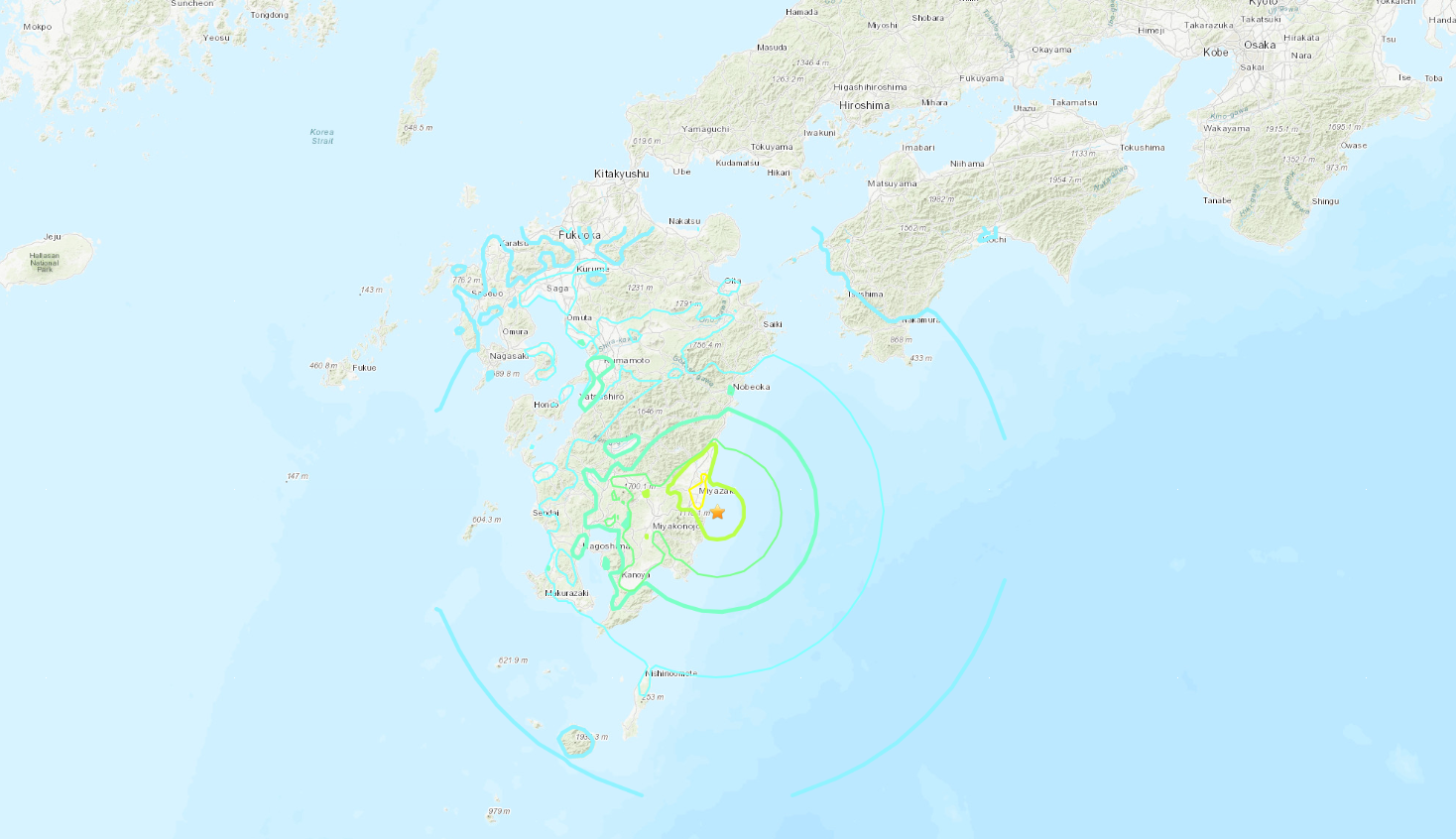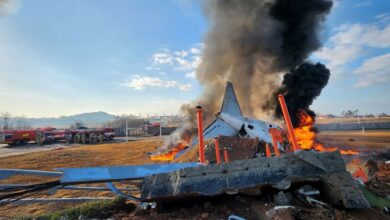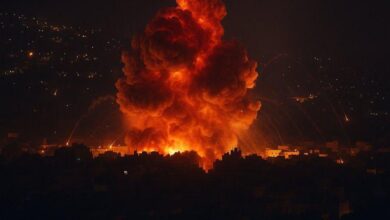M6.8 Earthquake Strikes Southwestern Japan, Triggering Tsunami Advisories
TOKYO (WE) – A powerful earthquake with a magnitude of 6.8 struck off the coast of southwestern Japan on Monday evening, prompting tsunami advisories and causing widespread concern across the region. The quake occurred at 9:19 p.m. local time, with its epicenter located in the Hyuga Nada Sea, off the coast of Miyazaki Prefecture in Kyushu. The Japan Meteorological Agency (JMA) initially reported the earthquake’s magnitude as 6.4, later revising it to 6.9, before settling on 6.8. The tremor registered a lower 5 on Japan’s seismic intensity scale of 0 to 7 in parts of Miyazaki Prefecture, including the cities of Miyazaki, Shintomi, and Takanabe.

Tsunami Advisories and Observations
Immediately following the quake, the JMA issued tsunami advisories for the coasts of Miyazaki and Kochi prefectures, warning of potential waves up to 1 meter high. Residents in coastal areas were urged to evacuate to higher ground as a precautionary measure. Within 30 minutes of the earthquake, a small tsunami was observed:
- Miyazaki Prefecture: Waves measuring approximately 20 centimeters (8 inches) in height.
- Kochi Prefecture: Waves of about 10 centimeters (4 inches) recorded.
Despite the relatively small size of the observed tsunamis, authorities continued to warn residents to stay away from coastal areas and waterways, emphasizing that tsunami waves can strike repeatedly.
Immediate Impact and Response
As of late Monday evening, there were no immediate reports of significant damage or injuries directly related to the earthquake. However, some disruptions were noted:
- Train Services: Sections of the Kyushu Shinkansen bullet train line were temporarily suspended.
- Power Infrastructure: No irregularities were reported at the Ikata Nuclear Power Plant in Ehime Prefecture or the Sendai and Genkai Nuclear Power Plants in Kyushu.
Emergency services and local authorities remained on high alert, monitoring the situation closely and preparing for potential aftershocks or further seismic activity.
Seismic Context and Future Concerns
Japan, situated along the Pacific “Ring of Fire,” is no stranger to seismic activity. This latest earthquake has raised concerns about the potential for a larger seismic event in the region. The JMA is investigating whether this earthquake might be linked to an increased risk of a megaquake in the Nankai Trough, a submarine trench running along the Pacific coast of southwestern Japan. The Nankai Trough is known for its potential to generate massive earthquakes, with historical events causing significant damage and loss of life. Experts at the JMA convened late Monday to assess the situation and determine whether to issue a warning related to the Nankai Trough. This assessment is particularly significant given that a similar alert was issued in August of the previous year following a magnitude 7.1 earthquake in the same region.
Public Safety Measures and Recommendations
In the wake of the earthquake, authorities have issued several recommendations to ensure public safety:
- Coastal Evacuation: Residents in affected areas are advised to stay away from the coast and seek higher ground.
- Aftershock Awareness: The public is warned to be prepared for potential aftershocks and to stay in safe locations.
- Infrastructure Caution: People are advised to be wary of broken glass and other debris, particularly in areas that experienced stronger shaking.
- Continued Vigilance: Despite the lifting of initial tsunami advisories, residents are urged to remain cautious and stay informed about any updates from official sources.
Read More:
- Trump’s Territorial Aspirations: A Closer Look at His Controversial Vision for Greenland, Panama Canal, and Canada
- Health Ministry Keeps Vigil on China’s HMPV Outbreak, No Immediate Concern for India
- Updat: South Korea’s Jeju Air Crash Death Toll Rises to 179, Investigations Continue Amid National Mourning
Scientific and Technological Response
Japan’s advanced earthquake monitoring system played a crucial role in the rapid response to this seismic event. The country’s network of seismographs and seismic intensity meters, operated by the JMA and other organizations, allows for quick detection and analysis of earthquakes. The Earthquake Phenomena Observation System (EPOS) at JMA headquarters in Tokyo and Osaka processes data from these instruments, enabling swift issuance of information about the earthquake’s hypocenter, magnitude, and observed seismic intensity.
International Reaction and Support
The international community has been closely monitoring the situation in Japan. The U.S. Geological Survey, which initially estimated the earthquake’s magnitude at 6.8, stated that there was no tsunami threat to the United States from this particular event. Neighboring countries and international organizations have expressed their readiness to provide assistance if needed, highlighting the global concern for Japan’s safety in the face of natural disasters.
Historical Context and Recent Seismic Activity
This earthquake comes in the wake of several significant seismic events in Japan, underscoring the country’s ongoing vulnerability to geological forces. On January 1, 2024, a powerful 7.6 magnitude earthquake struck the Noto Peninsula in Ishikawa Prefecture, resulting in over 500 fatalities and widespread destruction. That event was the deadliest earthquake in Japan since the 2011 Tōhoku earthquake and tsunami, which claimed nearly 20,000 lives and triggered a nuclear disaster at the Fukushima Daiichi power plant. Last August, another powerful earthquake struck off southern Japan, causing mostly minor injuries but raising concerns about potential major quakes stemming from the undersea trough east of the coast. These recent events have kept earthquake preparedness at the forefront of public consciousness and government policy, driving ongoing improvements in early warning systems, building codes, and emergency response protocols.
Long-term Seismic Risk
The occurrence of this earthquake has reignited discussions about the long-term seismic risks facing Japan, particularly concerning the Nankai Trough. Scientists estimate that there is a 70 to 80 percent chance of a magnitude 8 to 9 earthquake occurring in the Nankai Trough within the next 30 years. This sobering prediction underscores the critical importance of ongoing research, preparedness measures, and public education about earthquake safety in Japan.
As Japan navigates the immediate aftermath of this significant seismic event, the resilience and preparedness of its people and institutions are once again put to the test. While the initial impact appears to have been limited, the earthquake serves as a potent reminder of the ever-present seismic risks in the region. Authorities continue to monitor the situation closely, ready to respond to any developments. Meanwhile, the Japanese public, well-versed in earthquake preparedness, remains vigilant and cooperative in following safety guidelines. This event will undoubtedly contribute to ongoing scientific research and policy discussions aimed at further improving Japan’s already robust earthquake response systems. As the country moves forward, the lessons learned from this and previous earthquakes will be crucial in shaping future preparedness strategies and potentially saving lives in the face of future seismic challenges.















